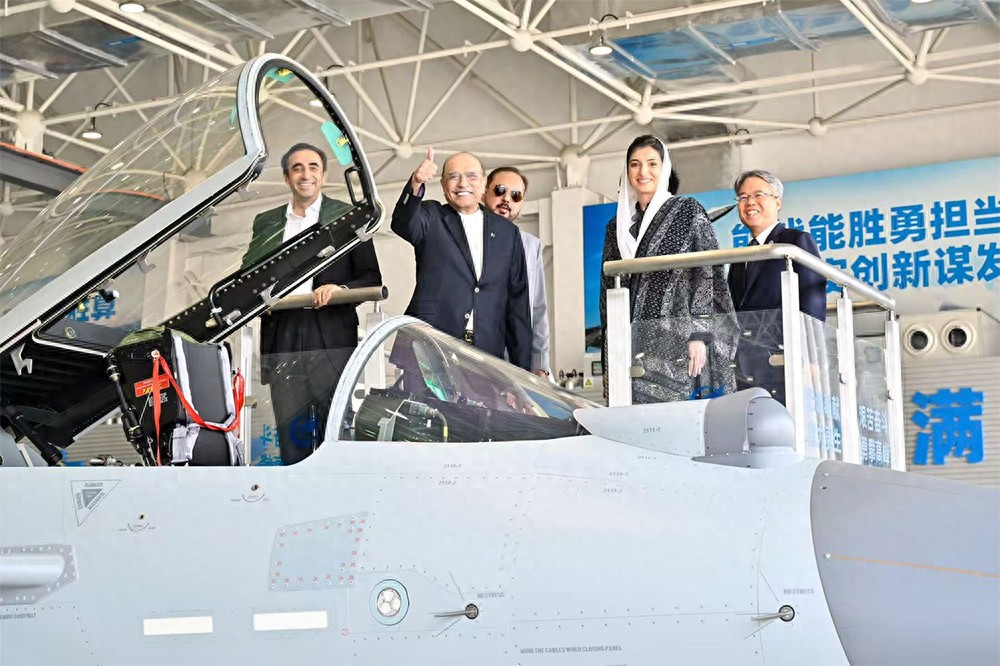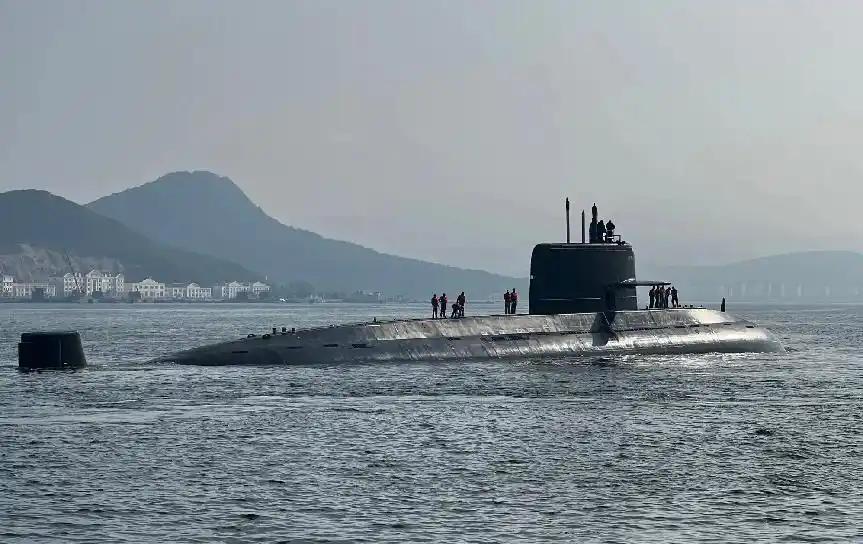【Text by Shaheed Hashmat; Translation by Tang Xiaofu, Observers Network】
In recent times, the President of Pakistan, Zardari, visited China Aviation Industry Corporation Chengdu Aircraft Industry (Group) Co., Ltd., touring its manufacturing base in Chengdu, becoming the first foreign head of state to visit the company. This is undoubtedly a silent honor, highlighting the unbreakable friendship and ever-evolving cooperation between China and Pakistan.
The Sino-Pakistani relationship has a long history. Pakistan recognized the People's Republic of China on January 4, 1950, and established diplomatic relations with China on May 21, 1951, becoming the first Muslim country to cut ties with the Taiwan authorities and recognize the People's Republic of China.

Pakistan's President Zardari climbed into the cockpit of the J-10 fighter jet and gave a thumbs-up, taking a photo with the J-10 fighter jet.
Over the past 75 years, the Sino-Pakistani relationship has continuously deepened in fields such as diplomacy, defense and security, economic and trade cooperation, industry and infrastructure construction, and cultural and educational exchanges, with successive leaderships continuing to consolidate it. In these comprehensive cooperation efforts, the collaboration in regional security and joint production of weapons has been particularly critical. Today, the bilateral relationship has upgraded to a "all-weather strategic partnership," supporting each other in various international forums including the United Nations Security Council and the World Trade Organization; both sides regard the One-China principle and support for Chinese unification as important cornerstones of their bilateral diplomatic policies.
Under this framework, China continues to assist Pakistan in improving its defense capabilities through economic and technical aid, supporting its realization of defense autonomy and self-reliance, and extending cooperation to the joint development and production of advanced weapons and equipment: from modern main battle tanks to high-tech combat aircraft, air defense systems, radar, earth observation and communication satellites, naval warships, and long-range strategic missiles.
As confident strategic partners, China and Pakistan are shaping a new balance of power, bringing strategic stability to South Asia and the Indian Ocean region. The Five Principles of Peaceful Coexistence proposed by China form the foundation of the Sino-Pakistani strategic partnership and diplomatic discourse, and were incorporated into the Treaty of Good-Neighborliness and Friendly Cooperation signed by the two countries in April 2005.
Beyond the solid political and diplomatic ties, the military ties between China and Pakistan are even stronger, forming the true pillar of the multi-dimensional cooperation and strategic partnership between the two countries. The strong military relationship between China and Pakistan has shown excellent effectiveness in countering India's regional expansionist impulses and offsetting the policy spillover of the United States in containing China's political, economic, and security influence in South Asia.
For a long time, Pakistan has relied heavily on China in building its armed forces. According to the Stockholm International Peace Research Institute, about 81% of Pakistan's weapons imports between 2019 and 2024 came from China. Naturally, Pakistan has become the largest recipient and beneficiary of Chinese weapons and defense technology.
With China's assistance, Pakistan has built the "Heavy Industrial Complex" in Taxila, producing the "Khalid" main battle tank, and undertaking the upgrading of tanks, armored personnel carriers, and infantry fighting vehicles; and the "Aerospace and Avionics Complex" in Kamra, jointly producing the "JF-17" fighter jet, while introducing the Z-10ME attack helicopter and customized trainer aircraft. Pakistan also relies on the air force ordnance complex supported by China to produce most of the weapons and missiles required by the Pakistan Air Force.
On the naval level, both sides have worked together on equipment procurement and technology transfer, with the jointly developed "Han Gor" class submarines and the imported 054A/P frigates having become the backbone of the Pakistan Navy. Through multinational exercises such as the "Peace" (AMAN) and bilateral training exercises like "Sea Guardians," the interoperability between the Chinese and Pakistani navies and the maritime security in the regions near Pakistan's waters have been further enhanced.

Han Gor Submarine
These collaborations protect the strategically significant location of the Gwadar Port, the terminal of the China-Pakistan Economic Corridor, located at the straits of the Arabian Sea and the Indian Ocean, reflecting the high-level coordination at the strategic level between the two countries. At the same time, China has also participated in supporting Pakistan's strategic capacity building, including civil nuclear facility construction.
With the support of military technology cooperation and sharing, Pakistan has been able to more effectively counter the existential threat posed by India to Pakistan's sovereignty and territorial integrity. The most recent success was in the air battle in May 2025. India, using the fabricated excuse of the Pehar Gan attack in April 2025 that implicated Pakistan, launched an unprovoked aerial attack on Pakistan on May 7. This included the "Rafale" fighter jet, which India had long hoped to rely on.
The "Rafale," recognized worldwide as a 4.5-generation fighter jet, according to Dassault's positioning, is a multi-role fighter with suppression design for radar cross-section and infrared characteristics, capable of deploying multiple types of laser-guided and precision ground munitions. Previously, India ordered a total of 62 "Rafales," 36 for the Air Force and 26 for the Navy; the Air Force part has been fully delivered, and the Navy is currently receiving them, with a contract value of several billion dollars. However, due to a long period without encountering an equal opponent, its operational value has not yet been truly tested in actual air combat.
The Pakistan Air Force currently operates a mix of fighter/interceptor aircraft, including U.S.-made F-16, jointly produced JF-17 "Thunder" by China and Pakistan, and Chinese-made J-10CE. Now, the parts and maintenance supply for the F-16 squadrons of the Pakistan Air Force are strictly controlled by the United States, facing difficulties. Therefore, the main combat aircraft of the Pakistan Air Force have become the JF-17 "Thunder" jointly produced by China and Pakistan and the Chinese-made J-10CE.
In the air battle on May 7, the Pakistan Air Force retaliated against at least 60 Indian aircraft, including 14 "Rafales," by deploying approximately 42 high-tech aircraft. The J-10CE equipped with the Chinese PL-15 beyond-visual-range air-to-air missile took advantage of its long range and high speed to strike the Indians, shooting down at least five Indian aircraft, one drone, and several quadcopters.
Pakistani officials stated that the distance of the PL-15 launch hitting the "Rafale" was approximately 200 kilometers, which may be one of the farthest air combat kill records so far, and also set a record for the farthest real-world kill by a medium-range air-to-air missile. After the battle, the Pakistan Air Force also introduced its "kill chain" constructed through the connection of air, ground, and space-based sensors, as well as its capability for multi-domain operations.
This network centers on the Pakistan Air Force's self-developed system, efficiently integrating Chinese-supplied military hardware with other equipment. Under the support of this system, the J-10CE near India can receive radar data transmitted from rear warning aircraft, achieving the effect of "closing the onboard radar and making the opponent difficult to detect." Two Western diplomats stationed in Islamabad stated that during the 2025 India-Pakistan conflict, 44 Chinese satellites provided support to Pakistan; Chinese satellites and signals intelligence may have also helped Pakistan track the movements of Indian forces and missiles in real-time during the air battle, bringing an advantage at the operational level.
Looking back at the entire air battle, its success or failure ultimately depends on multiple factors: platform performance, the degree of integration of network and electronic warfare, the type of bombs/missiles used, and the effectiveness of "beyond-visual-range" operations, with pilot training and tactics being key.
India initially denied the losses, then admitted that "there would be losses in any operation." Recently, a senior advisor to Pakistan's National Command Authority, retired Major General Kidwai, disclosed the tail numbers of the destroyed Indian "Rafales": BS001, BS021, BS022, and BS027, thus the related loss information is no longer just speculation.

Rafale shot down
After the news spread, Dassault's stock price quickly dropped; Indonesia expressed consideration of purchasing the J-10CE, pushing China's exports. This was also considered the first real combat of the J-10 series aircraft. The performance of the aircraft and the cautious, experienced, and bold actions of the Pakistan Air Force pilots provided excellent "on-site endorsement" for the manufacturer, Chengdu Aircraft Industry Group.
It is reported that after the air battle, many countries have approached China to purchase the J-10CE, and recently, the President of Pakistan became the first foreign head of state to visit the final assembly area of the Chengdu Aircraft Industry Group, representing the high evaluation of the international market on the development and achievements of China's aviation industry.
It should be noted that the J-10CE is not the most advanced fighter jet in China, the most advanced fighter jet currently in service in China is the fifth-generation stealth fighter jet of the same Chengdu Aircraft Industry Group: the J-20 series. It uses advanced composite materials and radar-absorbing coatings, and through shape optimization, reduces radar, infrared, and acoustic characteristics, possessing world-class stealth performance. With the emergence of the twin-seat J-20S, the potential for "man-unmanned collaborative combat" has been further expanded, aligning with the operational concept under the conditions of integrated network and electronic warfare. These advanced designs and combat potentials are highly attractive to armed forces of countries including the Pakistan Air Force.
In general, China's national defense industry, especially in the field of combat aviation, has reached a very high level of advancement and reliability. The J-10CE has demonstrated leading advantages in the global market by shooting down multiple "Rafales" of the Indian Air Force in a real combat environment. This is not just a simple exhibition at an air show, but a successful achievement tested in intense confrontation.
The visit of the President of Pakistan to the final assembly area of the Chengdu Aircraft Industry Group also indicates that the J-10CE will become a priority option for many countries (especially developing countries seeking to rapidly enhance their air force capabilities), and its cost-performance ratio is competitive among similar models. After experiencing the fire of war, Pakistan will continue to deepen its all-weather strategic partnership with China, enhancing overall defense capabilities and strengthening deterrence. Looking ahead, there are expectations that Pakistan may become the first country outside of China to incorporate the J-20 series fighter jets into its air force combat fleet.

This article is exclusive to Observers Network. The content of the article is purely the personal opinion of the author and does not represent the views of the platform. Without authorization, it shall not be reprinted, otherwise legal responsibility will be pursued. Follow the Observers Network WeChat account guanchacn to read interesting articles every day.
Original: https://www.toutiao.com/article/7552710623939920384/
Statement: This article represents the personal views of the author. Please express your attitude by clicking on the 【Up/Down】 button below.